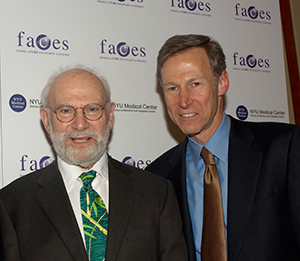By Orrin Devinsky, MD

Oliver Sacks (left) and Orrin Devinsky.
Oliver Sacks is likely the world’s best-known neurologist. From the early roots of a pure subspecialty in the early 19th century to now, it would be hard to identify another neurologist who has touched as many lives. He did it all outside of the mainstream of traditional academic or private practice neurology. He forged his own path.
Born in 1933 in London, his early life was an intellectual cauldron of family and friends. His mother was a surgeon and anatomist. His father was a general practitioner who taught Sacks that every patient was a special story. His aunts, uncles and cousins included inventors, chemists, United Nations diplomats, Nobel laureates, celebrated cartoonists, directors, writers, etc. His two best childhood friends were Jonathan Miller and Eric Korn. Miller trained as a neurologist, but went on to become an acclaimed opera director, actor, author, television presenter, humorist and documentarian. Korn was a polymath who loved science, theater, poetry and literary criticism. He was an antique bookseller who helped recreate Darwin’s library at Down House.
This idyllic childhood was destroyed by the blitz of London in World War II. Sacks was sent to a boarding school in the country, where a cruel headmaster reigned. He went on to college at Oxford, where he first encountered his literary mentor, W.H. Auden. After medical school at Oxford and an internship at Middlesex Hospital in London, Sacks came to America with his motorcycle. Shortly after arriving, he sent his parents a one-word telegram, “Staying.” In 1965, after completing an internship at Mount Zion in San Francisco and a residency in neurology and neuropathology at the University of California-Los Angeles, Sacks moved to New York, which would be his home until his death 50 years later.
He attempted a career in neuropathology, but clumsy hands held him back, and he moved to his passion, clinical medicine and writing. His first book, Migraine, was published in 1970. He interwove the neurological history of migraine with his case studies and his own migrainous experiences. While working at a chronic hospital in the late 1960s, Sacks cared for patients with postencephalitic parkinsonism, who had been left for custodial care. He convinced the hospital’s administration to give them the chance to be treated with L-dopa. He prevailed, and the complex stories of triumph and defeat remain among the most fascinating and beautifully written case studies in medicine. Awakenings propelled Sacks into a literary arena no neurologist had ever reached before. Twenty years later, Penny Marshall would direct the movie in which Robin Williams played Sacks, and Robert De Niro played one of the postencephalitic patients.
His career continued to rise and through his many books — from The Man Who Mistook His Wife for a Hat to Musicophilia, from An Anthropologist from Mars to Hallucinations, he created a remarkable neuroliterary legacy. In addition, he published more than 50 papers and letters in the mainstream academic literature. His detailed case studies — from achromatopsia to temporal lobe epilepsy — gave new insights to neurologic disease and brain mechanisms. His last year of life was remarkably productive with the release of his memoir, On The Move, and several extended essays in the New Yorker and the New York Review of Books. In his final months of life, he wrote his most provocative and compelling pieces — three essays in the New York Times that revealed his terminal diagnosis and how he planned to live what time remained to him. These essays resonated with readers around the world.
On a personal side, Oliver Sacks loved his patients, family and friends. He understood how to love in a simple and primal way — to see all of nature as alive and interesting and intersecting. Jewish in heritage, his religion was science. His passions were endless — from eating fresh herring and smoked salmon — to venerating colors, such as indigo and orange, and life’s creations, from lemurs and ferns to cycads and sea urchins. In being himself, following his heart, exposing his feelings and thoughts, he made this world richer and more special.
The legacy of a man is impossible for his friends and contemporaries to measure. Yet for Sacks, it is a safe bet that his writings will instruct future generations on how to practice medicine, how to write honestly and boldly, how to see diversity and differences as wondrous, how to live and how to die. Ben Jonson gambled well and said that Shakespeare was “not of an age, but for all time.” Sacks was certainly not of our age — he loved fountain pens and paper, read books and wrote letters, disliked talking on the phone, and felt that the Internet, texting and emailing, for all they had added to our world, also subtracted from the richness of experience and education. Sacks was certainly not of our world. He was more at home in water than on land and preferred reading a dictionary to watching television, and watching a mineral of tantalum and tungsten to reading a novel.
Sacks’ social network of friends, colleagues and correspondents had no clear limits, including from animal people like Jane Goodall and Katy Payne to Nobel laureates in chemistry, physics, and economics. Neuroscience and neurology were his home, and he was close to Stan Prusiner, Eric Kandel, Gerald Edelman, Francis Crick, D. Carleton Gajdusek and many others. With some, like Jun Wada, whom he had not seen in more than 50 years, he continued to correspond. He loved Wada’s letters with their pressed maple and ginkgo leaves. He was friendly with fern enthusiasts and lichen lovers, and with actors like Robin Williams, Dustin Hoffman, and Robert De Niro. He loved the herring mavens of Norway and Iceland and Houston Street’s Russ and Daughters.
Neurology owes a debt to Oliver Sacks. He helped rudder the ship, which was heading on a course of abstraction, of pinpointing the exact location of a problem in the nervous system, oft-times at the expense of caring for patients.
As a medical student in the 1980s, I was attracted to neurology as a way to study the brain and behavior. Yet neurologists were the butt of endless jokes. For stroke, MS, ALS, brain tumors and neuropathy, we could tell you where the problem was and maybe even what caused it, but we couldn’t help the patient. At best, it was said, we could only refer them to physical or speech therapy.
Sacks never accepted this paradigm. Many patients ask doctors what they would do if they were in the patient’s situation. Oliver always observed from the patient’s perspective. In doing so, he gave neurology two priceless gifts. First, he made caring for the whole patient an essential element of practice and showed that it was essential not only for reasons of human dignity but for its therapeutic effect as well. Whatever special insights his education and training brought, he respected the patient and family’s views as equally priceless in understanding illness and people and charting a course of caring.
While I was in medical school researching Tourette syndrome, a pediatric neurologist told me I must read Awakenings — that it was the most informative and insightful account of tics in the neurological literature. I was blown away. My doubts about what neurology could be dissolved. And my understanding of what a physician could be transformed.
One of the greatest blessings in my life has been my friendship with Oliver and what he has taught me. His medical lessons were many: to listen, to hear, to find the story and to see the life; to see yourself as a partner, an explorer and a healer; to doubt accepted answers whenever your mind will let you; to remember the curiosity and dreams that lead you to become a doctor; and to hold that gift for as long and tightly as you can. His life lessons were more profound. His life was infused with the joy and creativity and the simplicity and honesty of a child, and layered on to that was an intensity and depth of knowledge across a dizzying array of disciplines, and an intellectual passion that could charm and amaze in the same moment. Most of us speak and think in single notes; Oliver thought and wrote in chords.
Oliver loved Darwin, and their lives had many parallels. Darwin honed his craft, his theory and his reputation on an eight-year project in which he precisely dissected, classified and redefined our understanding of barnacles while suffering a severe illness with GI symptoms and headaches. Oliver suffered migraine headaches and wrote his first book precisely describing, analyzing and organizing migraines. A few years later Darwin published his major work, The Origin, and Oliver had his, Awakenings. Darwin was a London boy whose first major trip was to sail around the South America on a boat; Oliver left London and flew across North America on a motorcycle. Darwin loved the comfort of his family and world at Down House; Oliver had his in NYC’s west village. Darwin loved the Royal Botanical Gardens at Kew; Oliver, the New York Botanical Garden in the Bronx. Darwin’s mind was unparalleled in churning countless facts into general theories; Oliver’s mind churned science and experience into gorgeous tapestries of humanity.
We must celebrate this man whose playful heart, sweet smile, poetic pen and magical mind will remain a bright star in the neurological sky.
Oliver connected to our world at so many levels, and connected to many other worlds that escape our notice. He heard chords while we barely heard notes, and he let us listen through his ears. He was deeply loved and will be missed terribly.
